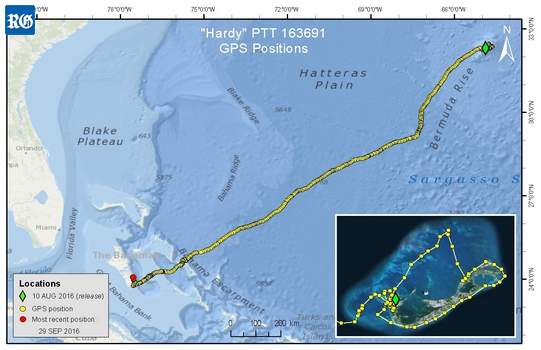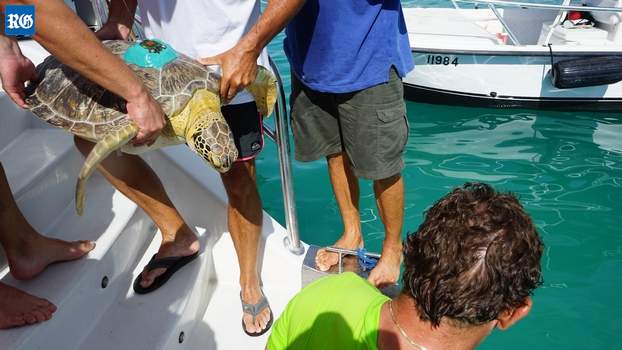Recent News
BIOS Scientist To Work With Ocean Tech ProjectFriday, August 05, 2016
A global marine research project designed to justify marine protected areas worldwide is set to launch in Bermuda next spring and will include the expertise of BIOS coral reef scientist Gretchen Goodbody-Gringley.
Daisy heads towards the Bahamas
Thursday, August 04, 2016
An endangered turtle rescued by fisherman off North Shore with a rusting hook caught in its trachea has left the island’s waters and is now swimming towards the Bahamas.
Subs exploring local waters
Sunday, July 31, 2016
Bermuda’s deep sea waters are being studied with submersibles by the international Nekton ocean exploration team, as part of Nekton’s XL Catlin Deep Ocean Survey.
Video: Nekton Mission’s First Submersible Dive
Tuesday, July 26, 2016
Nekton’s first deep ocean scientific research mission, which is sponsored by re/insurer XL Catlin and in partnership with the Bermuda Government’s Ministry of the Environment, launched off the coast of Bermuda this week, with the action caught on camera.
Ocean Scientific Research Mission To Launch
Tuesday, July 19, 2016
Nekton’s first deep ocean scientific research mission — sponsored by re/insurer XL Catlin and partnering with the Bermuda Government’s Ministry of the Environment — is preparing to launch off the coast of Bermuda this week.
About
GovernanceAbout Us
Newsletter
Latest News
Gift & Bookstore
Contact
General Inquiries
info@bzs.bm
Latest News
All the latest updates and news from the Bermuda Aquarium, Museum, and Zoo, one of Bermuda's leading visitor attractions!
Published Apr 13, 2017 at 1:09 pm (Updated Apr 19, 2017 at 7:09 am)

Hardy the green turtle's journey to the Bahamas (Image supplied)
A satellite transmitter crucial to the Bermuda Turtle Project has been found by a reef diver in the Bahamas.
The equipment was used to chart the progress of Hardy, a green turtle who swam 1,000 miles from Bermuda to the Caribbean country last year.
It had been missing since September after Hardy had reached Andros Island, and was found again after a collaborative effort involving a dozen people from Bermuda, the Bahamas and the United States.
According to the Bermuda Zoological Society, the recovery has enabled them to put together a “remarkably complete” track of Hardy’s migration — although the turtle’s whereabouts today remains a mystery.
The Turtle Project, a joint effort between BZS and the Sea Turtle Conservancy, aims to promote the conservation of turtles through research and education.
Describing Hardy’s progress, BZS said: “What was thought to be his final satellite location was recorded on September 29 at the southeastern end of Andros Island.
“Hardy appeared to be continuing his migration when this transmission was received. Why the transmissions stopped was not clear.
“To everyone’s surprise, after nearly two months of silence, the transmitter began sending location data again on November 27.
“Using Google Earth, BTP team members Robert Hardy and Anne Meylan could see from their office at the Florida Fish and Wildlife Research Institute in St Petersburg that all of the transmissions appeared to be coming from a house in the community of Bluff Settlement, a remote village on the southeastern coast of Andros Island.
“Recovering the transmitter would potentially mean recovering additional data, and also that this valuable GPS-enabled transmitter could be refurbished and used again.
“The team contacted Alan Bolten of the Archie Carr Centre for Sea Turtle Research to try to find a contact in the Bahamas who could investigate.

Photograph supplied
“Alan put the team in touch with Liz Brace of the Bahamas National Trust in Nassau, who in turn contacted one of the trust’s wardens, Steve Smith, based on Andros Island.
“A flyer was produced and distributed in Bluff Settlement, showing the approximate location of the turtle’s signal and seeking the community’s assistance in locating the transmitter.
“Weeks passed, and the BTP team was concerned that the battery on the unit would soon expire, greatly reducing the likelihood that the transmitter would be recovered.
“However, there was not much to do besides wait. On December 19, Anne received an e-mail from Patrick Talbot, Curator of the Bermuda Aquarium, Museum and Zoo.
“He had just spoken by phone with McRoy Wilson, manager of the Andros office of the Bahamas Ministry of Tourism, who reported that the satellite tag was now in his office at the tourism department on Andros.
“Mr Wilson had been contacted by the Bahamas National Trust warden and had retrieved the transmitter, then found Patrick’s phone number on the message glued to it.
“Patrick passed Mr Wilson’s contact information to Anne and she called him immediately. Mr Wilson confirmed that he had the tag and reported that it had been found by a diver on a reef along the east coast of Andros.
“This was consistent with the depth data transmitted by the tag when it was brought to the surface and resumed transmitting — the tag had been at about 20 feet below the surface the entire time it was not transmitting. No other details about the tag’s recovery were available.”
The transmitter was then taken to the lab in St Petersburg, where any untransmitted data could be downloaded.

Photograph supplied
“There is a limited commercial airline service connecting the east coast of Andros with the United States but Mr Wilson had a quick solution — a small airline called Watermakers Air that lands at an airstrip close to his office on Andros,” said BZS.
“A call to Jennifer Valencia at Watermakers was all it took to arrange pick up at Congo Town airport the following morning, and delivery a few hours later at an airport in Fort Lauderdale. Jennifer called to report the transmitter’s safe arrival and shipped it to the Florida Fish and Wildlife Research Institute in St Petersburg.
“The tag was a bit battered but still entirely functional. Robert Hardy, for whom the turtle had been named, downloaded the data stored on it and discovered that a large amount of information had remained on the tag — not just from the final days of deployment, but from the entire journey Hardy made from Bermuda to the Bahamas.
“The number of GPS co-ordinates for the travel path for this turtle increased from 365 to 785.
“With the added points, a remarkably complete track of the animal’s migration could be mapped. In addition to location data, the transmitter also recorded data on depth, temperature, and diving behaviour.
“The fate of the turtle Hardy remains unknown, but because of the remarkable collaboration of people from the Bahamas, Bermuda and the US, the satellite transmitter and some extremely important data on sea turtle migration were safely recovered. A big thanks to all.”


